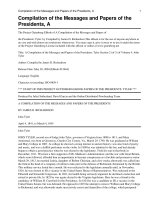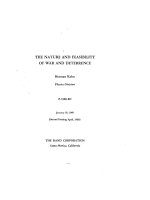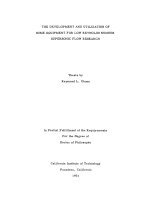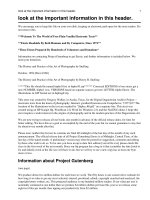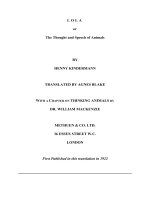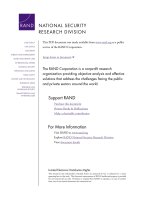understanding the ups and downs of blood glucose
Bạn đang xem bản rút gọn của tài liệu. Xem và tải ngay bản đầy đủ của tài liệu tại đây (283.56 KB, 29 trang )
Understanding the Ups and Downs of Blood
Glucose
Irl B. Hirsch, M.D.
University of Washington
Question
♦
Who has the greatest risk of proliferative diabetic
retinopathy (PDR) over the next 10 years
♦
A 55 y/o man with type 2 diabetes for 5 years,
on oral agents, A1c = 9.0%
♦
An 18 y/o man with 5 years of type 1 diabetes,
on BID NPH/R, A1c = 9.0%
♦
An 18 y/o man with 5 years of type 1 diabetes,
on CSII, A1c = 9.0%
Why are the risks of PDR different?
Postprandial hyperglycemia ≠ glycemic variability
Don’t forget about the
“ups” and “downs”!
“Oxidative Stress”
What Should You Know?
•
Oxygen is critical for life: respiration and energy
•
Oxygen is also implicated in many disease
processes, ranging from arthritis, cancer, Lou
Gehrig’s disease as well as aging
–
This dangerous form of oxygen is from the formation
of “free radicals” or “reactive oxygen species”, or
pro-oxidants
–
Normally, pro-oxidants are neutralized by anti-
oxidants
“Oxidative Stress”:
What You Should Know
Oxidative Stress =
Imbalance between pro-oxidants
(free radicals, reactive oxygen
species) and anti-oxidants
Oxidative Stress:
Why is it Important?
Free radicals (reactive
oxygen species) are
known to fuel diabetic
vascular complications
OK, What Turns On Oxidative Stress, Free
Radicals, and Reactive Oxygen Species
♦
High blood glucose
♦
Science is confirmed on this point
♦
Variability in blood glucose
♦
Science is highly suggestive on this point
How Does One Measure…?
♦
Oxidative Stress
♦
Urinary isoprostanes: best marker of oxidative
stress in total body
♦
“HbA1c of oxidative stress”
♦
Glycemic variability
♦
Mean Amplitude of Glycemic Excursions (MAGE)
♦
Standard deviation on SMBG meter download
I Hirsch
Correlation Between Urinary 8-iso-PGF2
alpha and MAGE in T2DM
1200
1000
800
600
400
200
0
0 20 40 60 80 100 120 140 160
Urinary 8-SO-PGF2 alpha Excretion Rates
(pg/mg creatinine)
MAGE (mg glucose/dL)
R=0.86, p<0.0001
JAMA 295:1688-97, 2006
I. Hirsch
Why This Study is So Important
♦
Oxidative stress not related to A1c, fasting
glucose, fasting insulin, mean blood glucose
♦
Stronger correlation of oxidative stress to
MAGE than to postprandial glucose levels!
♦
MAGE = both the UPS and the DOWNS of
blood glucose
I. Hirsch
So What Is The Significance of the
Understanding of GV?
♦
“…it suggests that different therapeutic strategies
now in use should be evaluated for their potential to
minimize glycemic excursion, as well as their ability
to lower A1c.”
♦
“…wider use of real-time continuous glucose
monitoring in clinical practice would provide the
required monitoring tool to minimize glycemic
variability and superoxide overproduction.”
Brownlee M, Hirsch IB:
JAMA: 295:1707, 2006
I. Hirsch
What About Long-Term Glycemic
Variability?
♦
Pittsburgh Epidemiology of Diabetes Complications
♦
16-year follow-up of childhood T1DM, N=408
♦
Results:
♦
Risks of coronary disease over time related to A1c
and variability of A1c!
Diabetes 55 (Supp 1): A1, 2006
What We KNOW
♦
Risk of complications are related to
♦
Glycemic exposure as measured as A1c
over time
♦
Proven
♦
Genetic risks
♦
Clearly true, but little understanding
♦
Glycemic variability
♦
Supported by most but not all studies
Conclusion 1
♦
Glycemic variability may be an important
mechanism increasing oxidative stress and
vascular complications
So how do we best
measure glycemic
variability in our patients
with diabetes?
I. Hirsch
What’s a better way to assess
glycemic variability?
I. Hirsch
Which Patient Has More Variable
Fasting Glucose Data?
60 54
148 146
70 203
165 132
110 79
185 68
210 138
144 252
75 144
138 77
Joe: HbA1c = 6.5%; on CSII
with insulin aspart
Mary: HbA1c = 6.5%; on
HS glargine and prandial
lispro
Mean = 123 mg% Mean = 123 mg%
SD = 51 SD = 63
I. Hirsch
Standard Deviation
♦
A measurement of glycemic variability
♦
Can determine both overall and time
specific SD
♦
Need sufficient data points
♦
Minimum 5 but prefer 10
I. Hirsch
Calculation To Determine SD Target
•
Ideally SD X 3 < mean, but extremely
difficult with type 1 patients
SD X 2 < MEAN
SD X 2 < MEAN
I. Hirsch
Significance of a High SD
♦
Insulin deficiency (especially good with fasting
blood glucose)
♦
Poor matching of calories (especially
carbohydrates) with insulin
♦
Gastroparesis
♦
Giving mealtime insulin late (or missing shots
completely)
♦
Erratic snacking
♦
Poor matching of basal insulin, need for CSII?
I. Hirsch
Other Significance of a High SD
I. Hirsch
Caveats of the SD
♦
Need sufficient SMBG data
♦
Low or high averages makes the
2XSD<mean rule irrelevant
I. Hirsch
Caveats of the SD: Low Mean
56
85
98
106
110
113
46
60
59
128
Mean = 81; SD = 29
I. Hirsch
Caveats of SD: High Mean
210
249
294
112
77
302
288
259
321
193
Mean = 217; SD = 82
I. Hirsch
Putting it all together
♦
Typical new patient visit to UW DCC
♦
27 y/o woman on CSII for 5 years
♦
Testing 4 to 5 times daily, A1c=6.4%
♦
Major problems with hypoglycemia unawareness
♦
Poor understanding of basic concepts of insulin
use despite seen by specialists for 20 years (last
appointment with endocrinologist was no more
than 12 min for her “new patient appointment”)
Question
♦
Who has the greatest risk of PDR over the next
10 years?
♦
A 55 y/o man with T2DM for 5 years, on oral
agents, A1c = 9.0%; Mean/SD = 210/50;
♦
An 18 y/o man with 5 years of T1DM, on BID
N/R, A1c = 9%; Mean/SD = 210/100;
♦
An 18 y/o man with 5 years of T1DM, on CSII,
A1c = 9% Mean/SD = 210/75;
After thinking about glycemic variability and oxidative stress

